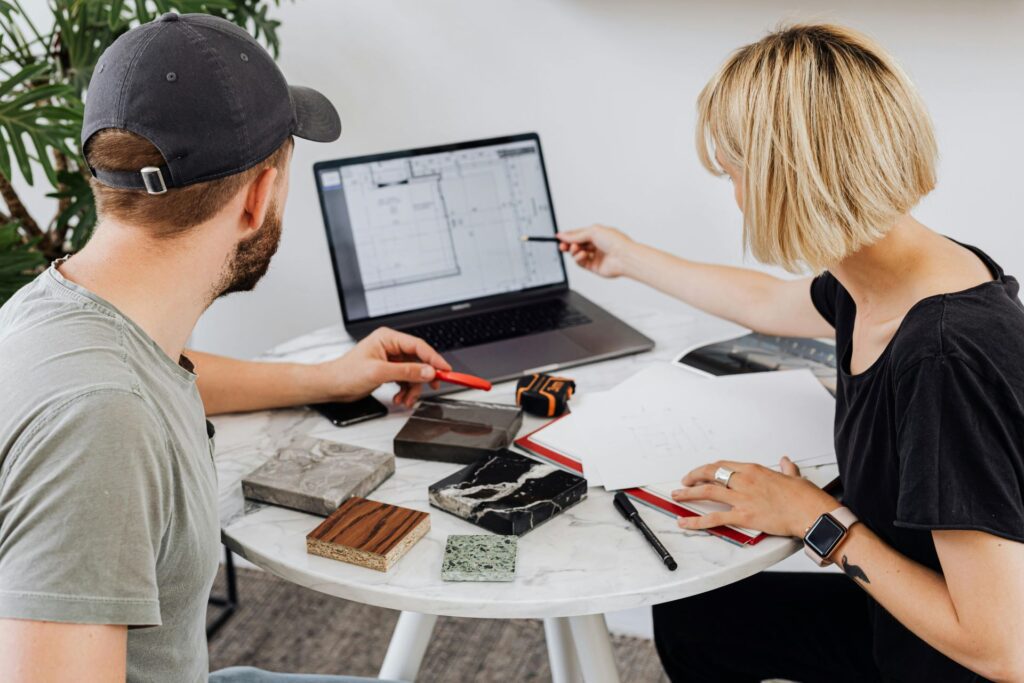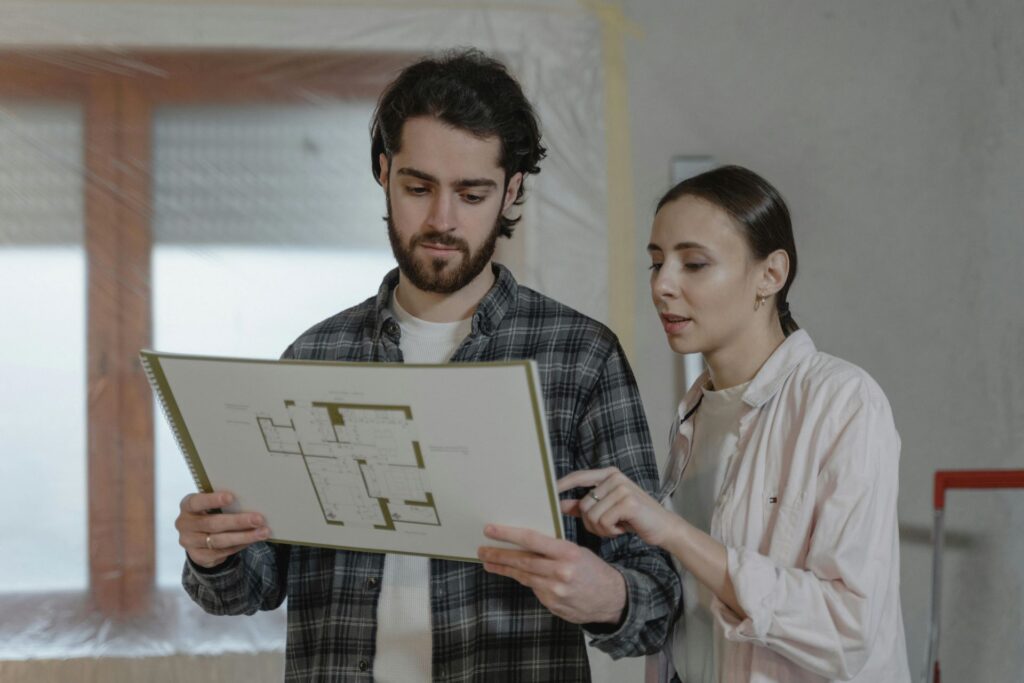In the world of construction and project execution, the relationship between architects, designers, and contractors is not just a formality; it’s the foundation of a successful project. Whether you’re building a luxury villa, designing a sleek modern office space, or embarking on a home renovation, the synergy between these professionals is what ensures that the project moves forward smoothly, stays within budget, and meets both aesthetic and functional goals.
Each of these experts brings something unique to the table: architects craft the structural blueprint, designers focus on bringing style and functionality to the interiors, and contractors ensure that these plans are transformed into reality. But without effective collaboration, even the best-laid plans can run into costly delays or miscommunication. Working together seamlessly allows these professionals to navigate challenges, maintain the project’s vision, and ultimately deliver a result that is both beautiful and functional.
In this article, we’ll dive deeper into why it’s essential for architects, designers, and contractors to collaborate and how their combined expertise leads to more streamlined, efficient, and successful outcomes for any construction project.
The Role of Architects in a Construction Project
Architects are at the core of the design and planning phase of any construction project, translating the client’s vision into a tangible blueprint that aligns form with function. Their role is multifaceted—they must ensure that the structural integrity of the building is sound while also delivering on the aesthetic and practical goals set by the client. The architect is responsible for creating detailed architectural plans that serve as the foundation for the work of both the designers and contractors. These plans outline the building’s structure, materials, and layout, ensuring every element fits together cohesively.
A crucial aspect of an architect’s work is to collaborate effectively with both contractors and designers. Without this collaboration, the architectural plans may face issues related to feasibility, budget, or timeframe. By working closely with these professionals from the very beginning, architects can ensure their designs are not only aesthetically pleasing but also practical and cost-effective. This teamwork allows for flexibility; if budget constraints or site conditions require changes, the architect can adjust the plans accordingly without compromising the overall vision.
Architects also play a significant role in regulatory compliance, ensuring that their designs adhere to local building codes, safety standards, and environmental considerations. Their job is to navigate these legal aspects, aligning the project with all necessary regulations while keeping the client’s needs and vision in focus.
How Architects Influence Design
The influence of an architect extends far beyond the initial blueprints. Throughout the construction process, architects collaborate closely with interior designers to make sure that the interior spaces reflect the building’s overall design concept. This partnership ensures that the layout, materials, and finishes are not only functional but also complement the architecture’s aesthetic and the client’s preferences.
In addition to their role in the construction phase, architects often help with the selection of furnishings, lighting, and finishing materials. Their expertise ensures that these choices are aligned with both the architectural style and the budget. By maintaining open lines of communication with both the designers and contractors, architects can anticipate and mitigate potential challenges, such as the availability of materials or unexpected design changes. This continuous collaboration minimizes delays, budget overruns, and misalignment between the building’s structure and its interiors.
In essence, architects are the driving force behind a project’s ability to merge artistic vision with structural practicality, acting as the bridge between the creative and the technical aspects of construction. Their deep involvement at every stage—design, collaboration, and execution—ensures a seamless journey from concept to completion.

The Designer’s Role: Bringing Vision to Life
While architects focus on the overall structure and ensuring the functionality of a project, it’s the designers who breathe life into the space. Designers are responsible for the interior and aesthetic elements, working to complement the architect’s vision while infusing it with creativity and style. They select the finishes, materials, furnishings, and lighting that create a cohesive and harmonious environment. From choosing color palettes to placing furniture, designers ensure the spaces are not just functional but also visually engaging and aligned with the architectural framework.
Designers play a crucial role in shaping the atmosphere of a building’s interior. They determine how people will experience the space—whether it feels cozy, luxurious, minimalist, or dynamic. A successful designer ensures that every choice, from the texture of the fabrics to the placement of decorative elements, enhances the functionality of the space while also reflecting the client’s tastes and lifestyle.
For the designer to realize their vision, collaboration with both architects and contractors is essential. By maintaining open communication, designers can ensure that their lighting plans, color schemes, and material selections align with the overall architectural vision. This coordination prevents misunderstandings and ensures that key design elements are installed correctly and on schedule.
Designers and Contractors: A Crucial Partnership
A strong working relationship between designers and contractors is fundamental to the success of any project. While the designer conceptualizes the look and feel of a space, it is the contractor who brings that vision to life through precise execution and skilled craftsmanship. The contractor follows the designer’s specifications for materials, layout, and installation techniques, ensuring the design is implemented accurately and efficiently.
Clear communication is key to preventing issues during construction. Designers rely on contractors to provide feedback on the practicality of their plans, such as whether certain materials are suitable for the environment or if the installation of fixtures and furniture can be done within the project’s timeframe and budget. Regular updates and site visits help both parties stay aligned, ensuring the design comes together as intended.
When designers and contractors collaborate effectively, they produce a seamless blend of form and function, creating a finished product that is both beautiful and practical. For example, a designer might propose a particular lighting installation that enhances the ambiance of a room, but it’s the contractor who ensures the proper wiring and placement to make the idea a reality. Together, their teamwork results in a cohesive space that reflects the original design vision while maintaining structural integrity and practicality.
The Contractor’s Role: Turning Plans into Reality
While architects and designers craft the vision for a project, it’s the contractors who bring that vision to life through hands-on execution. Contractors are responsible for managing the day-to-day construction activities, which include coordinating workers, scheduling tasks, ordering materials, and ensuring the project stays on track. They play an essential role in making sure the architect’s design and the designer’s aesthetic choices come together into a cohesive and functional building.
One of the contractor’s key responsibilities is ensuring that the project complies with local regulations and safety standards. This includes everything from adhering to building codes and zoning laws to maintaining worker safety on the construction site. A contractor’s ability to navigate these requirements while delivering on the client’s expectations is crucial to a project’s success.
In addition to their logistical and managerial roles, contractors must collaborate closely with both architects and designers to ensure that the project is executed in line with the original plans. This means maintaining the structural integrity outlined by the architect while integrating the aesthetic and functional elements chosen by the designer. Should any issues arise during construction—whether it’s a material shortage or unforeseen site conditions—contractors must provide solutions that stay true to the project’s objectives without compromising the overall vision.

Communication is Key
For any construction project to succeed, open and consistent communication between contractors, architects, and designers is essential. Contractors must keep all parties informed of the progress, any challenges faced, and potential adjustments required to stay within budget or on schedule. When issues arise—whether related to material selection, site conditions, or timelines—quick, informed decisions must be made to avoid costly delays or missteps.
Frequent communication allows the team to align their approach, ensuring that each decision contributes to the project’s success. For instance, if a particular material becomes unavailable, the contractor will collaborate with the designer and architect to identify a suitable replacement that meets both aesthetic and functional requirements. Regular updates from the contractor ensure that the project remains true to the initial design vision while adapting to the practical realities of the build.
When contractors, architects, and designers work together effectively, they create a cohesive project that balances design, function, and construction integrity. This collaboration ultimately leads to the successful delivery of a project that meets or exceeds the client’s expectations.
Benefits of Synergy Between Architects, Designers, and Contractors
The success of any construction project hinges on the ability of architects, designers, and contractors to work seamlessly together. The synergy that results from this collaboration unlocks numerous benefits, ensuring that projects are executed smoothly, stay within budget, and meet the client’s expectations. Here are the key benefits that arise when these professionals align their efforts:
Streamlined Execution
When architects, designers, and contractors collaborate from the very beginning of a project, the result is a streamlined execution. Clear communication among the team ensures that everyone is working with the same vision, avoiding miscommunication and reducing the likelihood of delays. Each professional understands their role and the timing of each phase of the project, which enables them to anticipate and address potential issues before they become problems. This synchronization allows the project to progress efficiently, from initial blueprints to final construction.
For example, if a contractor notices a potential conflict between the design and the materials available, quick communication with the designer and architect can help resolve the issue before it impacts the construction schedule.
Cost Efficiency
A major advantage of this collaboration is cost efficiency. When architects, designers, and contractors are in constant communication, they can address potential challenges early in the process, preventing costly revisions later on. Whether it’s selecting alternative materials that meet both aesthetic and budgetary requirements or adjusting designs to accommodate unforeseen site conditions, early problem-solving helps keep costs under control.
By aligning their efforts, the team can also optimize resources, avoiding unnecessary expenses and ensuring that the project remains within budget. This proactive approach to cost management not only protects the client’s investment but also enhances the overall profitability of the project.
Enhanced Creativity
One of the greatest benefits of a collaborative team is the enhanced creativity that emerges from the exchange of ideas. Architects, designers, and contractors each bring their own expertise and perspective to the table. When these professionals work together, they can push the boundaries of design and functionality by brainstorming innovative solutions. This can result in unique architectural features, creative material usage, or practical adjustments that elevate the overall project.
For instance, an architect’s structural vision might inspire the designer to create an interior layout that complements the building’s form, while the contractor can offer insights on the best techniques to bring those ideas to life within the construction constraints. This synergy often leads to breakthroughs that wouldn’t be possible if each party worked in isolation.
Client Satisfaction
Ultimately, the success of a project is measured by client satisfaction, and this is where the collaboration between architects, designers, and contractors truly shines. When the entire team works together to deliver a project that not only meets but exceeds the client’s vision, the result is a highly satisfied client. A cohesive team ensures that the final product reflects the client’s original design goals while remaining functional and within budget.
Additionally, by addressing potential issues early and ensuring smooth communication throughout the project, the team reduces the likelihood of surprises or costly delays, further ensuring the client’s happiness. A successful collaboration produces a high-quality final product, strengthens the team’s reputation, and fosters long-term relationships with clients.

Heveatecture’s Commitment to Seamless Collaboration
In any construction project, collaboration between architects, designers, and contractors is crucial to ensuring the success of the build. At Heveatecture, this collaborative approach is at the heart of everything they do. With a focus on creating sustainable, innovative, and visually stunning structures, Heveatecture understands the importance of aligning the creative vision with practical execution.
Heveatecture works closely with designers to ensure that the aesthetic choices—from the selection of materials to the finer interior details—are in harmony with the overall architectural framework. By incorporating eco-friendly materials and integrating modern design elements, they not only elevate the visual appeal but also enhance the building’s long-term functionality. This partnership results in spaces that are not only beautiful but also practical for everyday use.
Collaboration with contractors is another key aspect of Heveatecture’s philosophy. Their contractors are brought into the design process early, allowing for real-time feedback on the feasibility of architectural plans and material selections. This ensures that any challenges—whether related to budget, timelines, or construction logistics—are addressed well before they become obstacles. By fostering open communication among all team members, Heveatecture ensures that the final product is delivered on time, within budget, and in alignment with the client’s vision.
Through their collaborative approach, Heveatecture demonstrates how synergy between architects, designers, and contractors leads to more efficient, sustainable, and high-quality construction projects, creating spaces that exceed client expectations in every way.

Conclusion
In construction and project execution, the collaboration between architects, designers, and contractors is vital to achieving a successful and cohesive outcome. The synergy among these professionals ensures that the project stays true to the original vision while remaining practical and feasible within the given constraints. Architects provide the structural and conceptual foundation, designers add creativity and aesthetic refinement, and contractors turn those plans into reality by managing the logistics and construction.
This collaborative approach creates a harmonious balance between form and function, ensuring that each phase of the project aligns with the overall goals. By working together, these experts address challenges early, avoid miscommunication, and deliver a final product that not only meets but often exceeds the client’s expectations. The result is a well-executed project that is both beautiful and functional, showcasing the power of teamwork in the world of construction.
10 FAQs on Collaborating with Architects and Designers
Collaboration between architects and designers ensures that the structural integrity and aesthetic appeal of a project are aligned with the client’s vision. Architects focus on functionality and form, while designers work to create visually pleasing interiors that enhance the overall experience. Together, they ensure the project is cohesive and meets both practical and artistic goals.
Contractors benefit from collaboration by receiving clear and comprehensive guidance, which helps them accurately execute designs and avoid misunderstandings during construction. By understanding both the architectural structure and the designer’s vision, contractors can implement the plans smoothly and efficiently, reducing errors or costly revisions.
The architect’s role is to provide the structural design and ensure that the building complies with all safety regulations and functional requirements. Architects balance the client’s vision with technical demands, including spatial planning, materials, and sustainability. Their goal is to create a blueprint that not only reflects the client’s preferences but also supports the building’s long-term structural integrity.
Designers collaborate with architects to ensure that the interior design complements the building’s overall structure and aesthetic. They take the architectural framework provided and craft interior spaces that enhance the flow and functionality of the rooms. By aligning color schemes, materials, and finishes with the architectural vision, designers help create a seamless transition between the exterior and interior of a building.
Clear and consistent communication between architects, designers, and contractors is essential to avoid misunderstandings. Open dialogue ensures that potential issues are addressed quickly, preventing delays and budget overruns. When all parties are aligned and informed, the project can proceed more smoothly, reducing the risk of costly mistakes or rework.
Yes, contractors play an important role in providing feedback on the practicality and cost-effectiveness of certain materials or designs. Their hands-on experience allows them to foresee potential challenges in execution and suggest alternatives that meet both the architect’s and designer’s vision while remaining feasible within the project’s budget.
Without collaboration, miscommunication can lead to delays, budget overruns, and a final product that fails to meet the client’s expectations. For instance, if designers and contractors do not collaborate, there could be conflicts between design elements and construction limitations, which could result in costly last-minute changes.
By working closely together, architects, designers, and contractors can identify and address potential issues early in the project. Early problem-solving helps avoid expensive revisions or change orders later in construction. Additionally, aligning on material choices and installation techniques ensures that the project stays within the allocated budget.
Contractor feedback is crucial during the design phase because contractors bring practical insights into how certain designs or materials will perform during construction. Their expertise helps ensure that the designs are not only aesthetically pleasing but also practical and cost-effective to implement.
When architects, designers, and contractors work together, their combined expertise leads to innovative solutions. For example, an architect’s structural idea might inspire a designer’s creative approach to interior spaces, while a contractor might suggest a new material or technique that improves both functionality and visual appeal. This collaborative creativity elevates the entire project.
